Swinburne INF80025: Bookbarn's Transformation Case Study Analysis
VerifiedAdded on 2023/01/16
|22
|5012
|34
Report
AI Summary
This report presents a comprehensive analysis of the Bookbarn case study, focusing on its transformation in management and operations systems. The analysis begins with the identification of key problems, including outdated resources, inefficiencies in administrative structures, lack of high-order handling, absence of IT infrastructure, resistance to change, manual ordering systems, competitive threats, and customer dissatisfaction. The report then delves into the analysis of these issues, utilizing the Ackoff framework to explore problem-solving approaches such as absolution, resolution, solution, and dissolution. The relevance of hard and soft system thinking is examined in relation to the identified problems. Stakeholders and problem owners are identified, along with their concerns. The report also discusses recommendable models, tools, and techniques such as flowcharts, UML, and DFD. The case study involves the application of Soft System Methodology (SSM) to address the identified issues and suggests strategies for improvement, including the redesign of processes and the implementation of computerized systems. The report also highlights the importance of stakeholder management and the need for a strategic approach to business transformation to ensure the long-term success of Bookbarn.
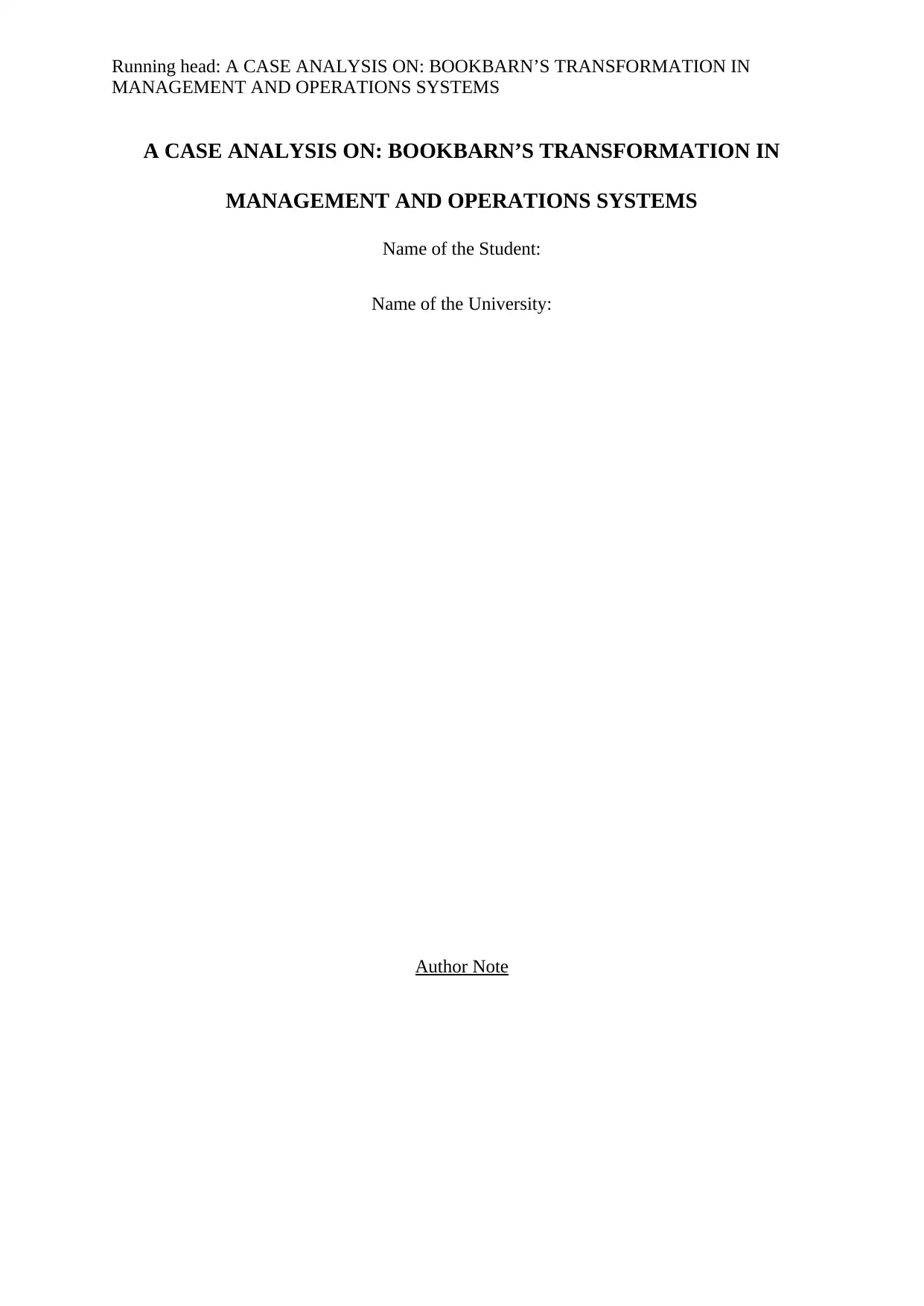
Running head: A CASE ANALYSIS ON: BOOKBARN’S TRANSFORMATION IN
MANAGEMENT AND OPERATIONS SYSTEMS
A CASE ANALYSIS ON: BOOKBARN’S TRANSFORMATION IN
MANAGEMENT AND OPERATIONS SYSTEMS
Name of the Student:
Name of the University:
Author Note
MANAGEMENT AND OPERATIONS SYSTEMS
A CASE ANALYSIS ON: BOOKBARN’S TRANSFORMATION IN
MANAGEMENT AND OPERATIONS SYSTEMS
Name of the Student:
Name of the University:
Author Note
Paraphrase This Document
Need a fresh take? Get an instant paraphrase of this document with our AI Paraphraser
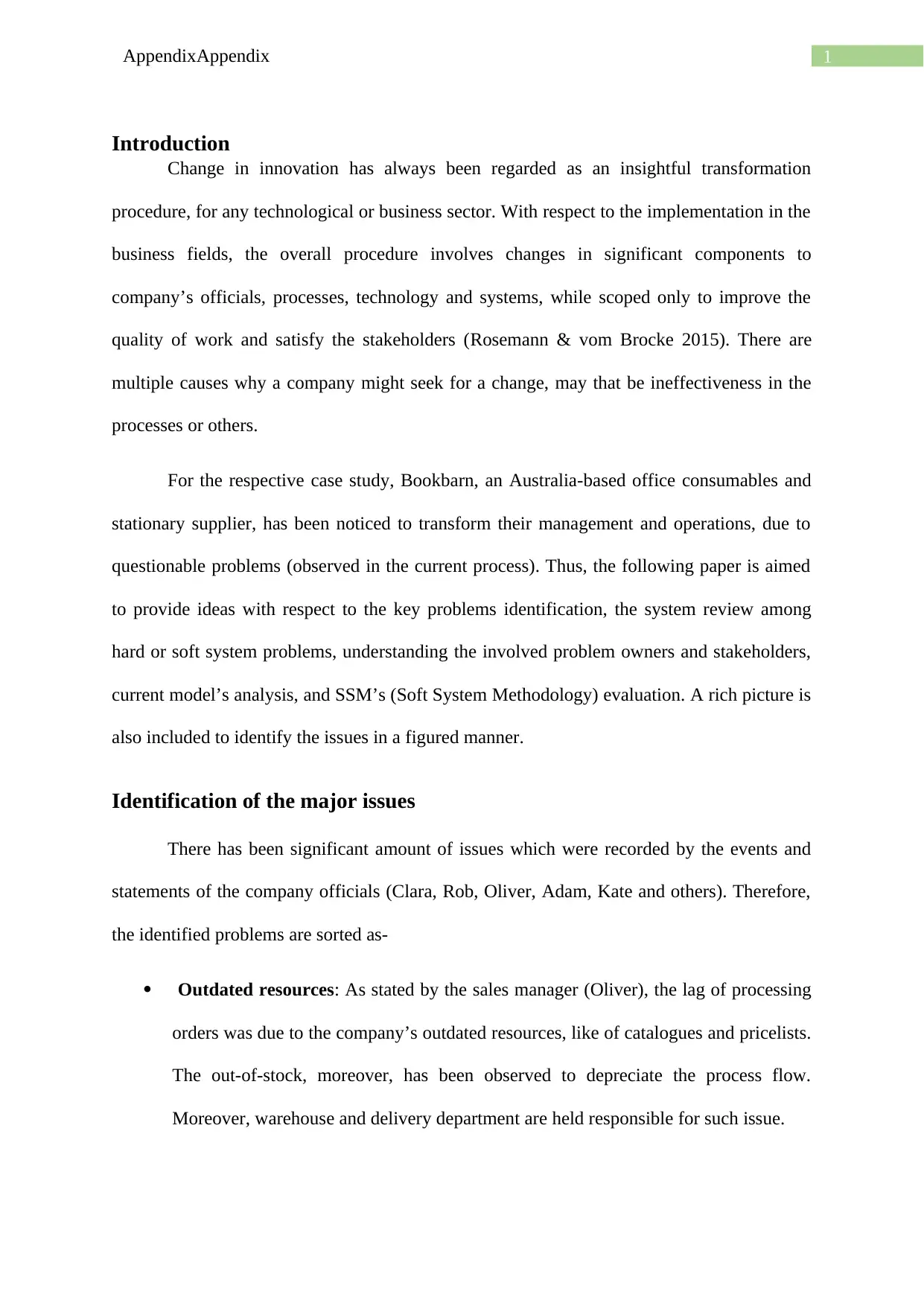
1AppendixAppendix
Introduction
Change in innovation has always been regarded as an insightful transformation
procedure, for any technological or business sector. With respect to the implementation in the
business fields, the overall procedure involves changes in significant components to
company’s officials, processes, technology and systems, while scoped only to improve the
quality of work and satisfy the stakeholders (Rosemann & vom Brocke 2015). There are
multiple causes why a company might seek for a change, may that be ineffectiveness in the
processes or others.
For the respective case study, Bookbarn, an Australia-based office consumables and
stationary supplier, has been noticed to transform their management and operations, due to
questionable problems (observed in the current process). Thus, the following paper is aimed
to provide ideas with respect to the key problems identification, the system review among
hard or soft system problems, understanding the involved problem owners and stakeholders,
current model’s analysis, and SSM’s (Soft System Methodology) evaluation. A rich picture is
also included to identify the issues in a figured manner.
Identification of the major issues
There has been significant amount of issues which were recorded by the events and
statements of the company officials (Clara, Rob, Oliver, Adam, Kate and others). Therefore,
the identified problems are sorted as-
Outdated resources: As stated by the sales manager (Oliver), the lag of processing
orders was due to the company’s outdated resources, like of catalogues and pricelists.
The out-of-stock, moreover, has been observed to depreciate the process flow.
Moreover, warehouse and delivery department are held responsible for such issue.
Introduction
Change in innovation has always been regarded as an insightful transformation
procedure, for any technological or business sector. With respect to the implementation in the
business fields, the overall procedure involves changes in significant components to
company’s officials, processes, technology and systems, while scoped only to improve the
quality of work and satisfy the stakeholders (Rosemann & vom Brocke 2015). There are
multiple causes why a company might seek for a change, may that be ineffectiveness in the
processes or others.
For the respective case study, Bookbarn, an Australia-based office consumables and
stationary supplier, has been noticed to transform their management and operations, due to
questionable problems (observed in the current process). Thus, the following paper is aimed
to provide ideas with respect to the key problems identification, the system review among
hard or soft system problems, understanding the involved problem owners and stakeholders,
current model’s analysis, and SSM’s (Soft System Methodology) evaluation. A rich picture is
also included to identify the issues in a figured manner.
Identification of the major issues
There has been significant amount of issues which were recorded by the events and
statements of the company officials (Clara, Rob, Oliver, Adam, Kate and others). Therefore,
the identified problems are sorted as-
Outdated resources: As stated by the sales manager (Oliver), the lag of processing
orders was due to the company’s outdated resources, like of catalogues and pricelists.
The out-of-stock, moreover, has been observed to depreciate the process flow.
Moreover, warehouse and delivery department are held responsible for such issue.
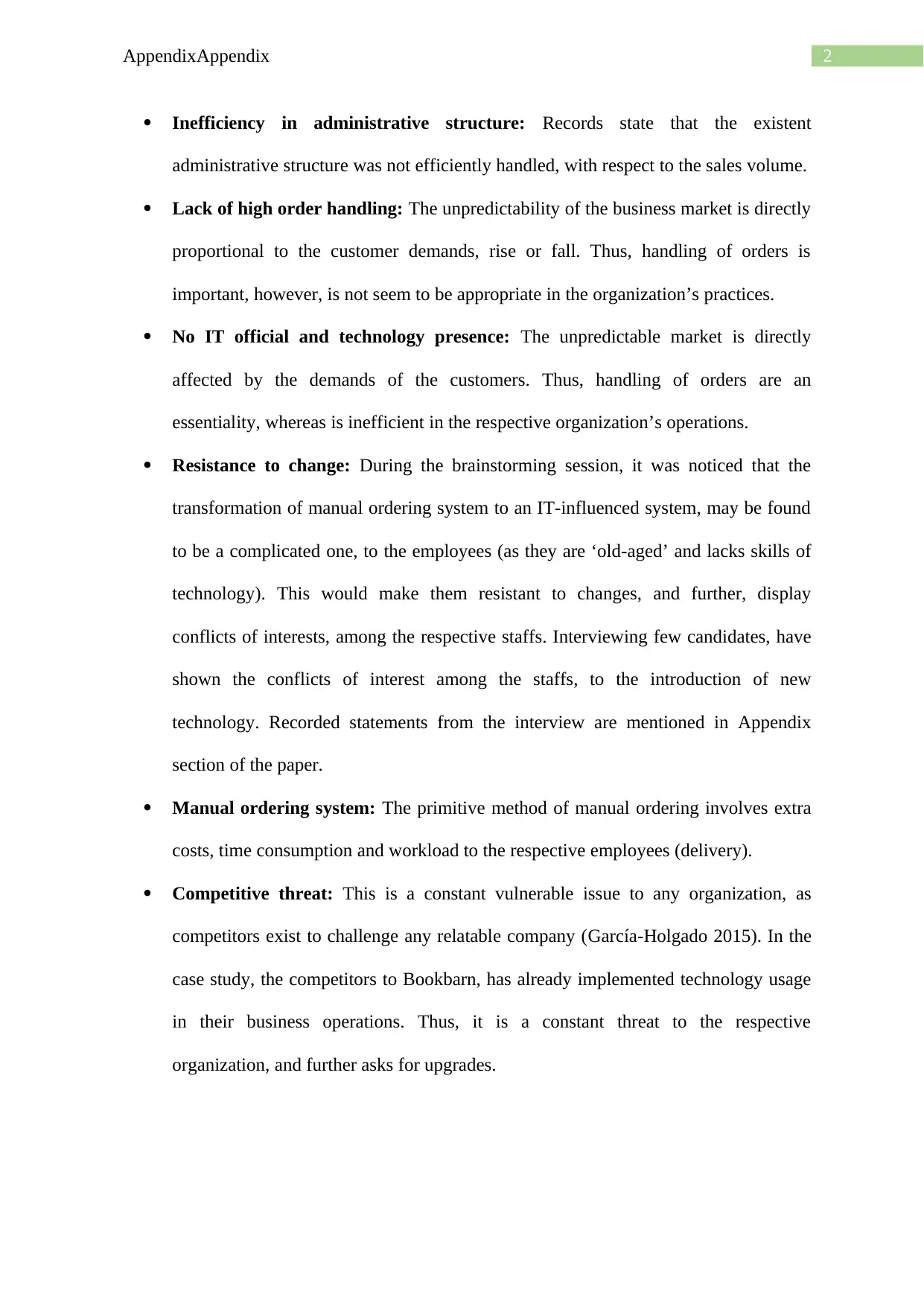
2AppendixAppendix
Inefficiency in administrative structure: Records state that the existent
administrative structure was not efficiently handled, with respect to the sales volume.
Lack of high order handling: The unpredictability of the business market is directly
proportional to the customer demands, rise or fall. Thus, handling of orders is
important, however, is not seem to be appropriate in the organization’s practices.
No IT official and technology presence: The unpredictable market is directly
affected by the demands of the customers. Thus, handling of orders are an
essentiality, whereas is inefficient in the respective organization’s operations.
Resistance to change: During the brainstorming session, it was noticed that the
transformation of manual ordering system to an IT-influenced system, may be found
to be a complicated one, to the employees (as they are ‘old-aged’ and lacks skills of
technology). This would make them resistant to changes, and further, display
conflicts of interests, among the respective staffs. Interviewing few candidates, have
shown the conflicts of interest among the staffs, to the introduction of new
technology. Recorded statements from the interview are mentioned in Appendix
section of the paper.
Manual ordering system: The primitive method of manual ordering involves extra
costs, time consumption and workload to the respective employees (delivery).
Competitive threat: This is a constant vulnerable issue to any organization, as
competitors exist to challenge any relatable company (García-Holgado 2015). In the
case study, the competitors to Bookbarn, has already implemented technology usage
in their business operations. Thus, it is a constant threat to the respective
organization, and further asks for upgrades.
Inefficiency in administrative structure: Records state that the existent
administrative structure was not efficiently handled, with respect to the sales volume.
Lack of high order handling: The unpredictability of the business market is directly
proportional to the customer demands, rise or fall. Thus, handling of orders is
important, however, is not seem to be appropriate in the organization’s practices.
No IT official and technology presence: The unpredictable market is directly
affected by the demands of the customers. Thus, handling of orders are an
essentiality, whereas is inefficient in the respective organization’s operations.
Resistance to change: During the brainstorming session, it was noticed that the
transformation of manual ordering system to an IT-influenced system, may be found
to be a complicated one, to the employees (as they are ‘old-aged’ and lacks skills of
technology). This would make them resistant to changes, and further, display
conflicts of interests, among the respective staffs. Interviewing few candidates, have
shown the conflicts of interest among the staffs, to the introduction of new
technology. Recorded statements from the interview are mentioned in Appendix
section of the paper.
Manual ordering system: The primitive method of manual ordering involves extra
costs, time consumption and workload to the respective employees (delivery).
Competitive threat: This is a constant vulnerable issue to any organization, as
competitors exist to challenge any relatable company (García-Holgado 2015). In the
case study, the competitors to Bookbarn, has already implemented technology usage
in their business operations. Thus, it is a constant threat to the respective
organization, and further asks for upgrades.
⊘ This is a preview!⊘
Do you want full access?
Subscribe today to unlock all pages.

Trusted by 1+ million students worldwide
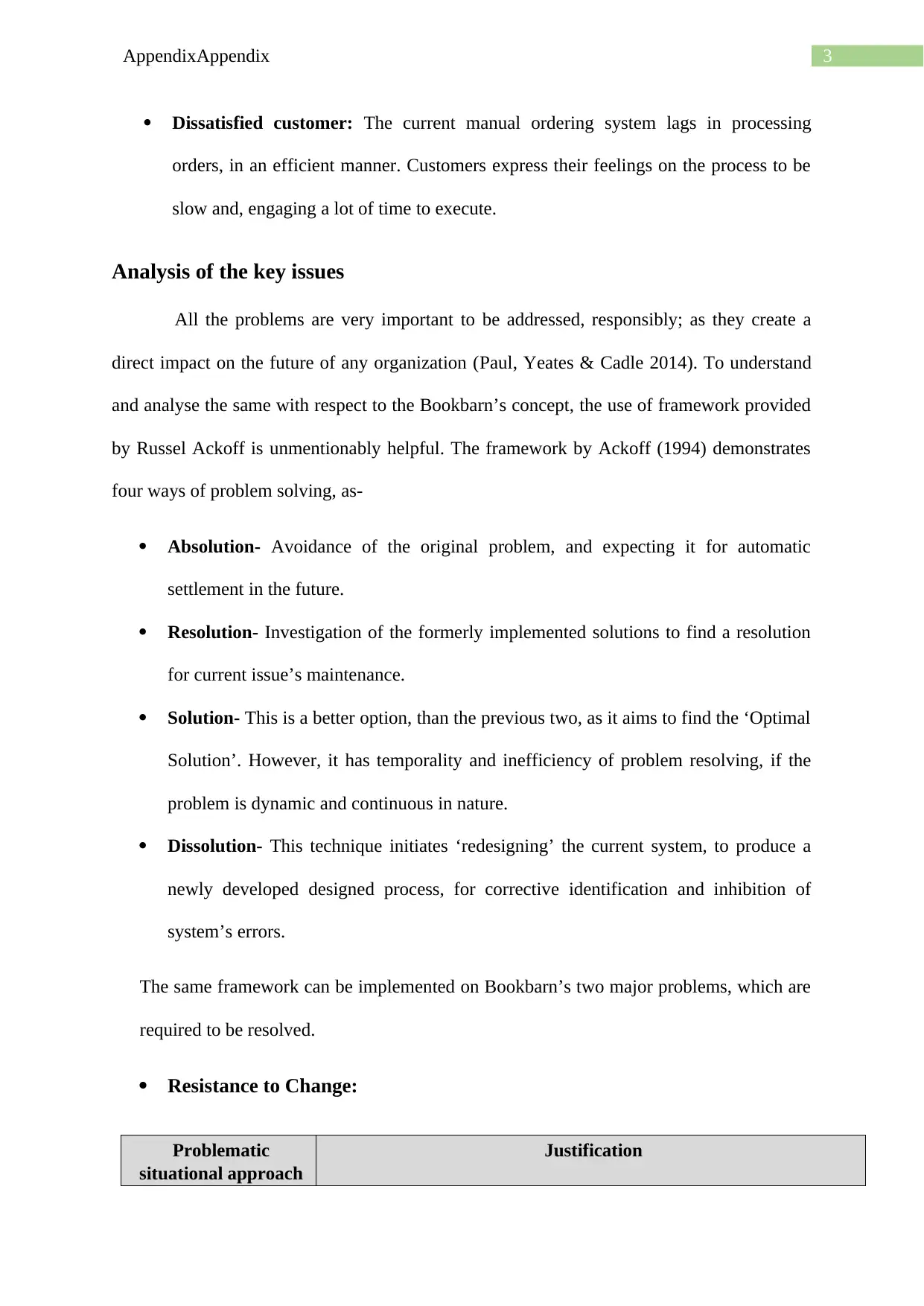
3AppendixAppendix
Dissatisfied customer: The current manual ordering system lags in processing
orders, in an efficient manner. Customers express their feelings on the process to be
slow and, engaging a lot of time to execute.
Analysis of the key issues
All the problems are very important to be addressed, responsibly; as they create a
direct impact on the future of any organization (Paul, Yeates & Cadle 2014). To understand
and analyse the same with respect to the Bookbarn’s concept, the use of framework provided
by Russel Ackoff is unmentionably helpful. The framework by Ackoff (1994) demonstrates
four ways of problem solving, as-
Absolution- Avoidance of the original problem, and expecting it for automatic
settlement in the future.
Resolution- Investigation of the formerly implemented solutions to find a resolution
for current issue’s maintenance.
Solution- This is a better option, than the previous two, as it aims to find the ‘Optimal
Solution’. However, it has temporality and inefficiency of problem resolving, if the
problem is dynamic and continuous in nature.
Dissolution- This technique initiates ‘redesigning’ the current system, to produce a
newly developed designed process, for corrective identification and inhibition of
system’s errors.
The same framework can be implemented on Bookbarn’s two major problems, which are
required to be resolved.
Resistance to Change:
Problematic
situational approach
Justification
Dissatisfied customer: The current manual ordering system lags in processing
orders, in an efficient manner. Customers express their feelings on the process to be
slow and, engaging a lot of time to execute.
Analysis of the key issues
All the problems are very important to be addressed, responsibly; as they create a
direct impact on the future of any organization (Paul, Yeates & Cadle 2014). To understand
and analyse the same with respect to the Bookbarn’s concept, the use of framework provided
by Russel Ackoff is unmentionably helpful. The framework by Ackoff (1994) demonstrates
four ways of problem solving, as-
Absolution- Avoidance of the original problem, and expecting it for automatic
settlement in the future.
Resolution- Investigation of the formerly implemented solutions to find a resolution
for current issue’s maintenance.
Solution- This is a better option, than the previous two, as it aims to find the ‘Optimal
Solution’. However, it has temporality and inefficiency of problem resolving, if the
problem is dynamic and continuous in nature.
Dissolution- This technique initiates ‘redesigning’ the current system, to produce a
newly developed designed process, for corrective identification and inhibition of
system’s errors.
The same framework can be implemented on Bookbarn’s two major problems, which are
required to be resolved.
Resistance to Change:
Problematic
situational approach
Justification
Paraphrase This Document
Need a fresh take? Get an instant paraphrase of this document with our AI Paraphraser
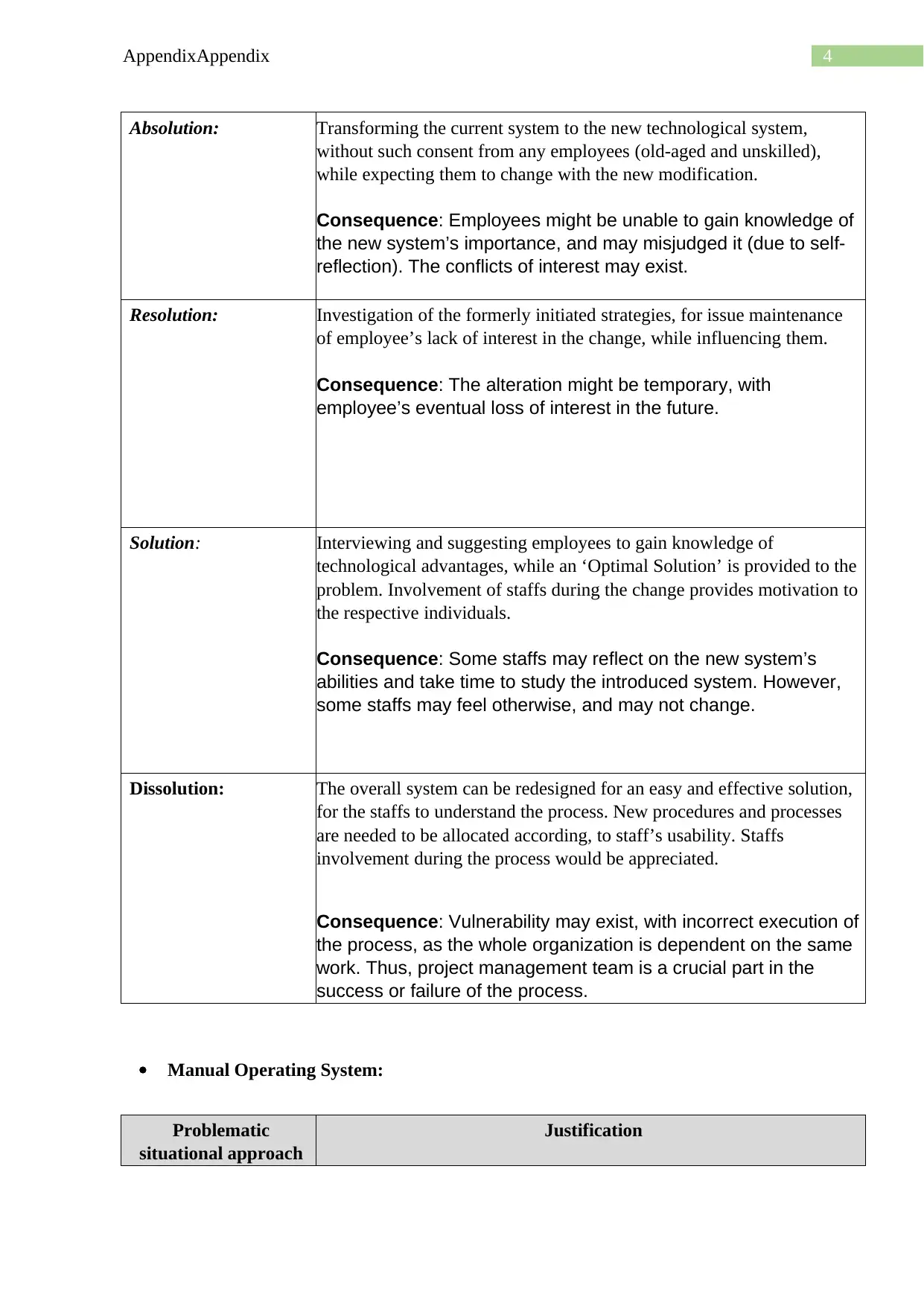
4AppendixAppendix
Absolution: Transforming the current system to the new technological system,
without such consent from any employees (old-aged and unskilled),
while expecting them to change with the new modification.
Consequence: Employees might be unable to gain knowledge of
the new system’s importance, and may misjudged it (due to self-
reflection). The conflicts of interest may exist.
Resolution: Investigation of the formerly initiated strategies, for issue maintenance
of employee’s lack of interest in the change, while influencing them.
Consequence: The alteration might be temporary, with
employee’s eventual loss of interest in the future.
Solution: Interviewing and suggesting employees to gain knowledge of
technological advantages, while an ‘Optimal Solution’ is provided to the
problem. Involvement of staffs during the change provides motivation to
the respective individuals.
Consequence: Some staffs may reflect on the new system’s
abilities and take time to study the introduced system. However,
some staffs may feel otherwise, and may not change.
Dissolution: The overall system can be redesigned for an easy and effective solution,
for the staffs to understand the process. New procedures and processes
are needed to be allocated according, to staff’s usability. Staffs
involvement during the process would be appreciated.
Consequence: Vulnerability may exist, with incorrect execution of
the process, as the whole organization is dependent on the same
work. Thus, project management team is a crucial part in the
success or failure of the process.
Manual Operating System:
Problematic
situational approach
Justification
Absolution: Transforming the current system to the new technological system,
without such consent from any employees (old-aged and unskilled),
while expecting them to change with the new modification.
Consequence: Employees might be unable to gain knowledge of
the new system’s importance, and may misjudged it (due to self-
reflection). The conflicts of interest may exist.
Resolution: Investigation of the formerly initiated strategies, for issue maintenance
of employee’s lack of interest in the change, while influencing them.
Consequence: The alteration might be temporary, with
employee’s eventual loss of interest in the future.
Solution: Interviewing and suggesting employees to gain knowledge of
technological advantages, while an ‘Optimal Solution’ is provided to the
problem. Involvement of staffs during the change provides motivation to
the respective individuals.
Consequence: Some staffs may reflect on the new system’s
abilities and take time to study the introduced system. However,
some staffs may feel otherwise, and may not change.
Dissolution: The overall system can be redesigned for an easy and effective solution,
for the staffs to understand the process. New procedures and processes
are needed to be allocated according, to staff’s usability. Staffs
involvement during the process would be appreciated.
Consequence: Vulnerability may exist, with incorrect execution of
the process, as the whole organization is dependent on the same
work. Thus, project management team is a crucial part in the
success or failure of the process.
Manual Operating System:
Problematic
situational approach
Justification
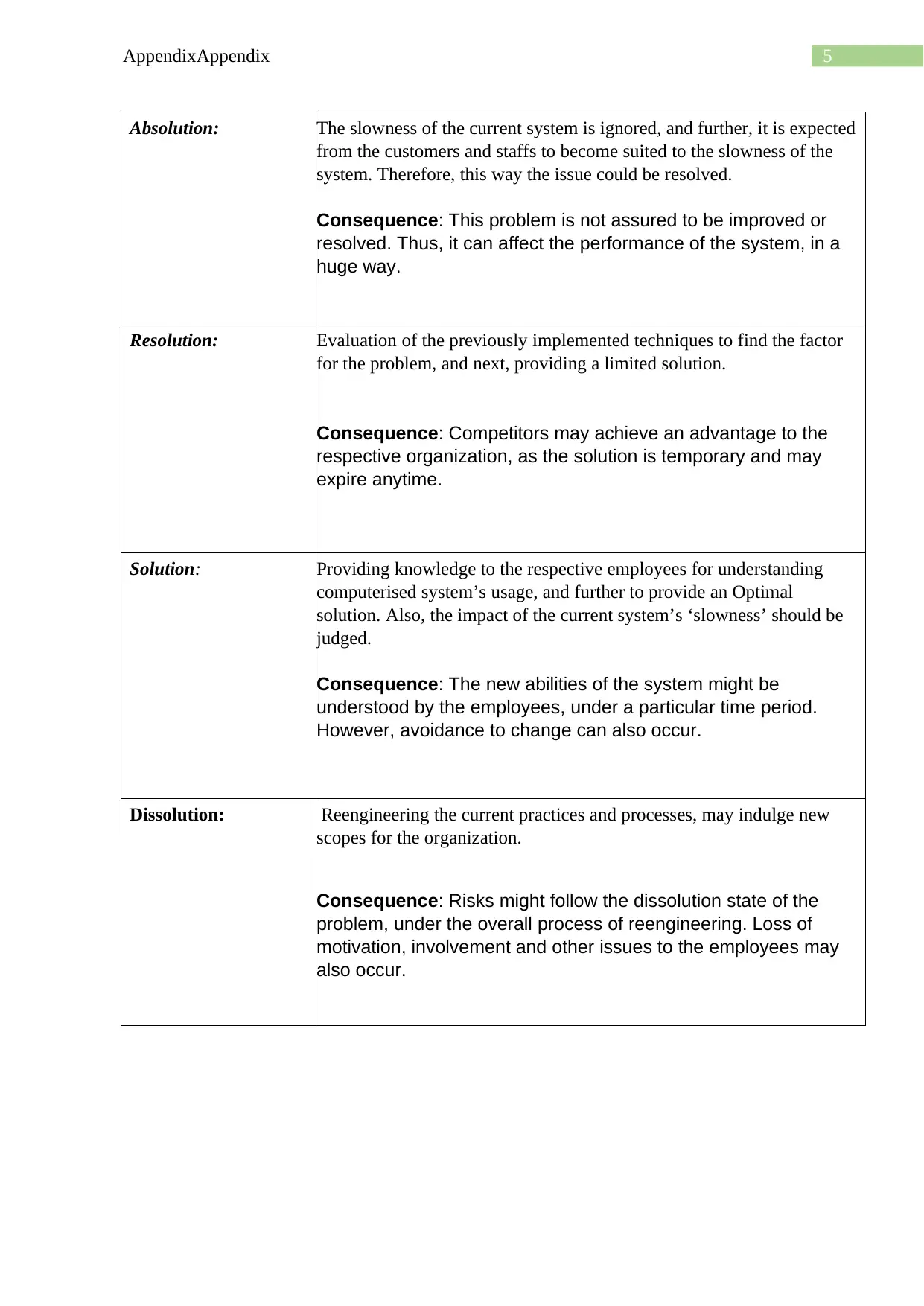
5AppendixAppendix
Absolution: The slowness of the current system is ignored, and further, it is expected
from the customers and staffs to become suited to the slowness of the
system. Therefore, this way the issue could be resolved.
Consequence: This problem is not assured to be improved or
resolved. Thus, it can affect the performance of the system, in a
huge way.
Resolution: Evaluation of the previously implemented techniques to find the factor
for the problem, and next, providing a limited solution.
Consequence: Competitors may achieve an advantage to the
respective organization, as the solution is temporary and may
expire anytime.
Solution: Providing knowledge to the respective employees for understanding
computerised system’s usage, and further to provide an Optimal
solution. Also, the impact of the current system’s ‘slowness’ should be
judged.
Consequence: The new abilities of the system might be
understood by the employees, under a particular time period.
However, avoidance to change can also occur.
Dissolution: Reengineering the current practices and processes, may indulge new
scopes for the organization.
Consequence: Risks might follow the dissolution state of the
problem, under the overall process of reengineering. Loss of
motivation, involvement and other issues to the employees may
also occur.
Absolution: The slowness of the current system is ignored, and further, it is expected
from the customers and staffs to become suited to the slowness of the
system. Therefore, this way the issue could be resolved.
Consequence: This problem is not assured to be improved or
resolved. Thus, it can affect the performance of the system, in a
huge way.
Resolution: Evaluation of the previously implemented techniques to find the factor
for the problem, and next, providing a limited solution.
Consequence: Competitors may achieve an advantage to the
respective organization, as the solution is temporary and may
expire anytime.
Solution: Providing knowledge to the respective employees for understanding
computerised system’s usage, and further to provide an Optimal
solution. Also, the impact of the current system’s ‘slowness’ should be
judged.
Consequence: The new abilities of the system might be
understood by the employees, under a particular time period.
However, avoidance to change can also occur.
Dissolution: Reengineering the current practices and processes, may indulge new
scopes for the organization.
Consequence: Risks might follow the dissolution state of the
problem, under the overall process of reengineering. Loss of
motivation, involvement and other issues to the employees may
also occur.
⊘ This is a preview!⊘
Do you want full access?
Subscribe today to unlock all pages.

Trusted by 1+ million students worldwide
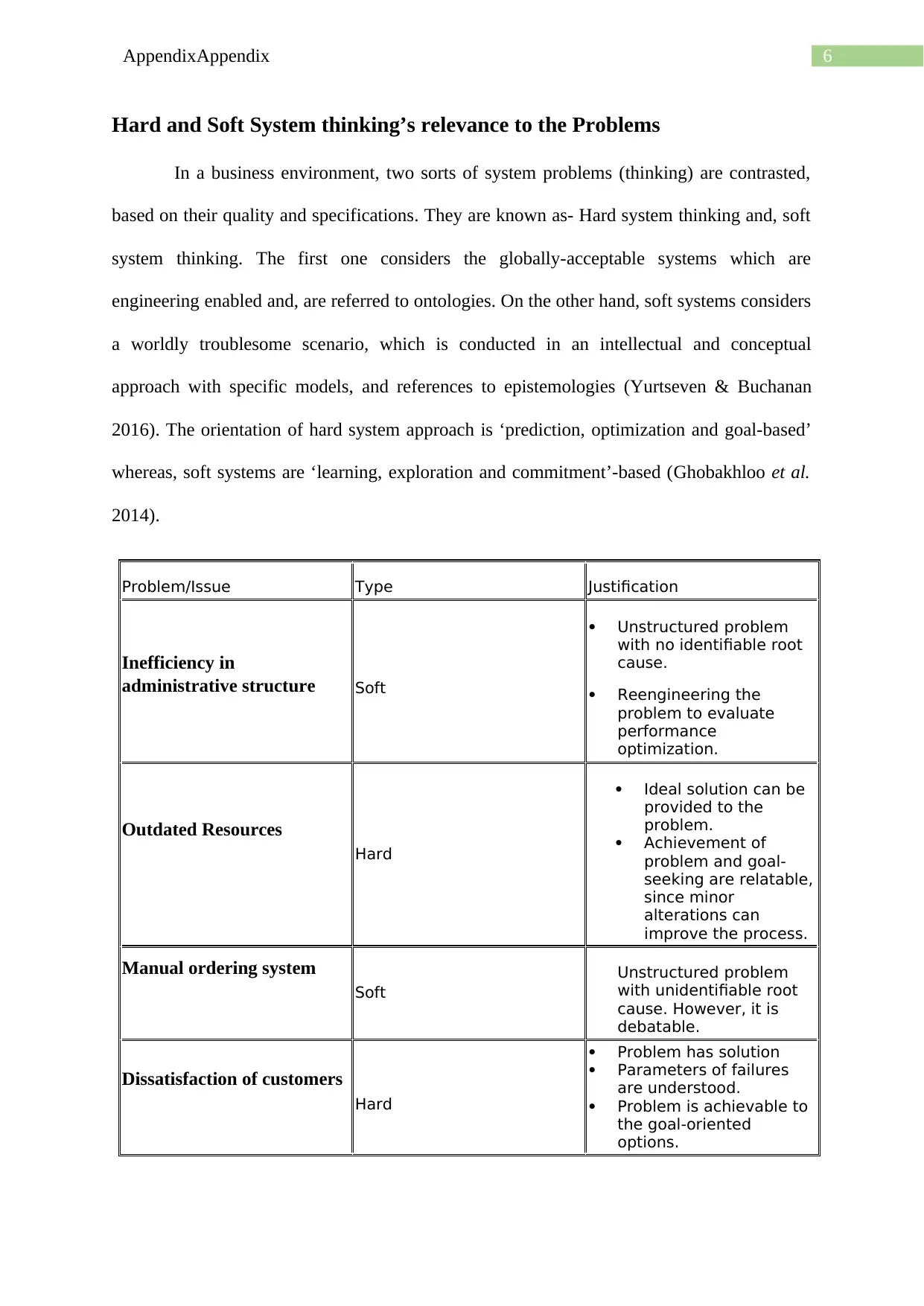
6AppendixAppendix
Hard and Soft System thinking’s relevance to the Problems
In a business environment, two sorts of system problems (thinking) are contrasted,
based on their quality and specifications. They are known as- Hard system thinking and, soft
system thinking. The first one considers the globally-acceptable systems which are
engineering enabled and, are referred to ontologies. On the other hand, soft systems considers
a worldly troublesome scenario, which is conducted in an intellectual and conceptual
approach with specific models, and references to epistemologies (Yurtseven & Buchanan
2016). The orientation of hard system approach is ‘prediction, optimization and goal-based’
whereas, soft systems are ‘learning, exploration and commitment’-based (Ghobakhloo et al.
2014).
Problem/Issue Type Justification
Inefficiency in
administrative structure Soft
Unstructured problem
with no identifiable root
cause.
Reengineering the
problem to evaluate
performance
optimization.
Outdated Resources
Hard
Ideal solution can be
provided to the
problem.
Achievement of
problem and goal-
seeking are relatable,
since minor
alterations can
improve the process.
Manual ordering system
Soft
Unstructured problem
with unidentifiable root
cause. However, it is
debatable.
Dissatisfaction of customers
Hard
Problem has solution
Parameters of failures
are understood.
Problem is achievable to
the goal-oriented
options.
Hard and Soft System thinking’s relevance to the Problems
In a business environment, two sorts of system problems (thinking) are contrasted,
based on their quality and specifications. They are known as- Hard system thinking and, soft
system thinking. The first one considers the globally-acceptable systems which are
engineering enabled and, are referred to ontologies. On the other hand, soft systems considers
a worldly troublesome scenario, which is conducted in an intellectual and conceptual
approach with specific models, and references to epistemologies (Yurtseven & Buchanan
2016). The orientation of hard system approach is ‘prediction, optimization and goal-based’
whereas, soft systems are ‘learning, exploration and commitment’-based (Ghobakhloo et al.
2014).
Problem/Issue Type Justification
Inefficiency in
administrative structure Soft
Unstructured problem
with no identifiable root
cause.
Reengineering the
problem to evaluate
performance
optimization.
Outdated Resources
Hard
Ideal solution can be
provided to the
problem.
Achievement of
problem and goal-
seeking are relatable,
since minor
alterations can
improve the process.
Manual ordering system
Soft
Unstructured problem
with unidentifiable root
cause. However, it is
debatable.
Dissatisfaction of customers
Hard
Problem has solution
Parameters of failures
are understood.
Problem is achievable to
the goal-oriented
options.
Paraphrase This Document
Need a fresh take? Get an instant paraphrase of this document with our AI Paraphraser
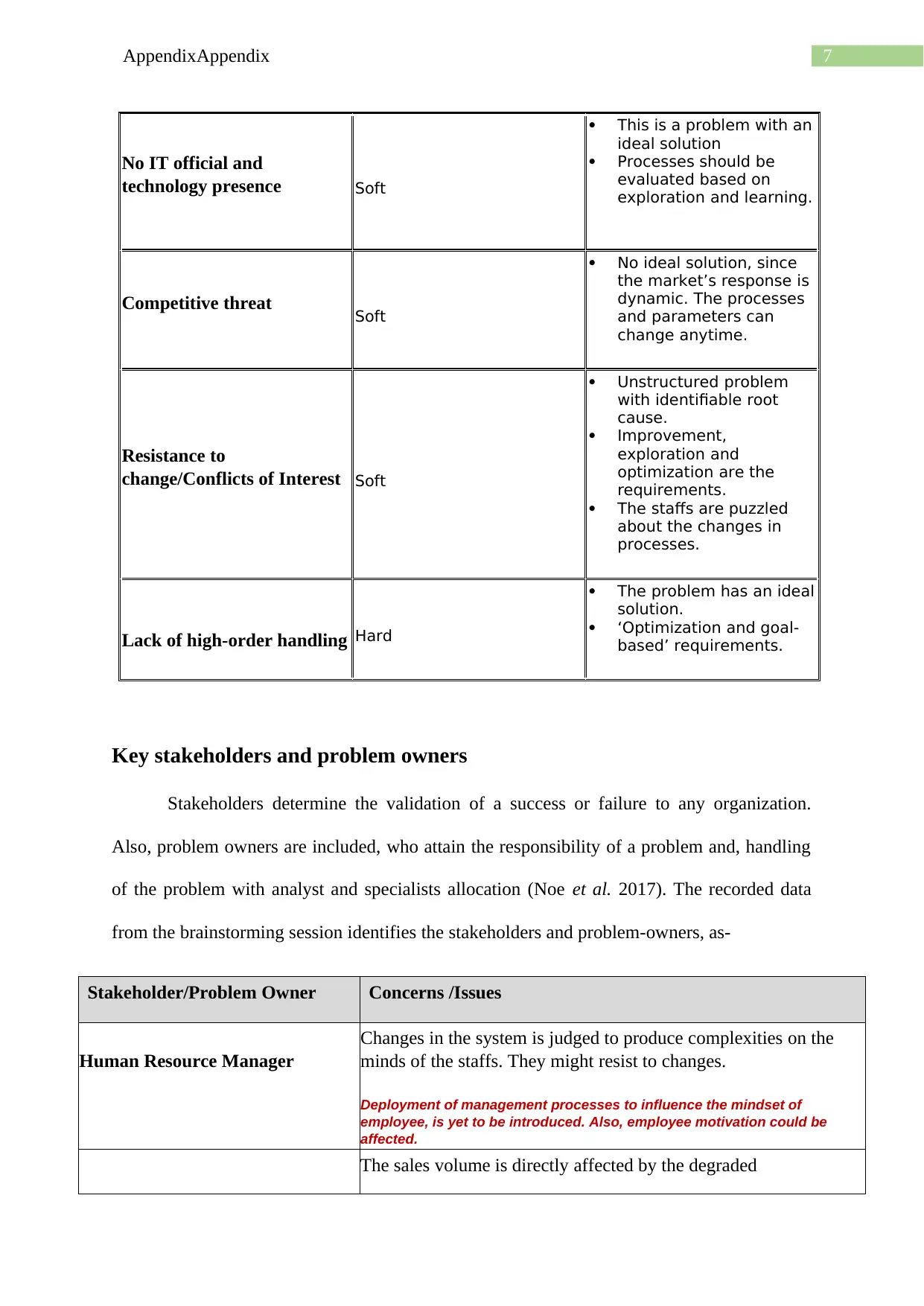
7AppendixAppendix
No IT official and
technology presence Soft
This is a problem with an
ideal solution
Processes should be
evaluated based on
exploration and learning.
Competitive threat Soft
No ideal solution, since
the market’s response is
dynamic. The processes
and parameters can
change anytime.
Resistance to
change/Conflicts of Interest Soft
Unstructured problem
with identifiable root
cause.
Improvement,
exploration and
optimization are the
requirements.
The staffs are puzzled
about the changes in
processes.
Lack of high-order handling Hard
The problem has an ideal
solution.
‘Optimization and goal-
based’ requirements.
Key stakeholders and problem owners
Stakeholders determine the validation of a success or failure to any organization.
Also, problem owners are included, who attain the responsibility of a problem and, handling
of the problem with analyst and specialists allocation (Noe et al. 2017). The recorded data
from the brainstorming session identifies the stakeholders and problem-owners, as-
Stakeholder/Problem Owner Concerns /Issues
Human Resource Manager
Changes in the system is judged to produce complexities on the
minds of the staffs. They might resist to changes.
Deployment of management processes to influence the mindset of
employee, is yet to be introduced. Also, employee motivation could be
affected.
The sales volume is directly affected by the degraded
No IT official and
technology presence Soft
This is a problem with an
ideal solution
Processes should be
evaluated based on
exploration and learning.
Competitive threat Soft
No ideal solution, since
the market’s response is
dynamic. The processes
and parameters can
change anytime.
Resistance to
change/Conflicts of Interest Soft
Unstructured problem
with identifiable root
cause.
Improvement,
exploration and
optimization are the
requirements.
The staffs are puzzled
about the changes in
processes.
Lack of high-order handling Hard
The problem has an ideal
solution.
‘Optimization and goal-
based’ requirements.
Key stakeholders and problem owners
Stakeholders determine the validation of a success or failure to any organization.
Also, problem owners are included, who attain the responsibility of a problem and, handling
of the problem with analyst and specialists allocation (Noe et al. 2017). The recorded data
from the brainstorming session identifies the stakeholders and problem-owners, as-
Stakeholder/Problem Owner Concerns /Issues
Human Resource Manager
Changes in the system is judged to produce complexities on the
minds of the staffs. They might resist to changes.
Deployment of management processes to influence the mindset of
employee, is yet to be introduced. Also, employee motivation could be
affected.
The sales volume is directly affected by the degraded
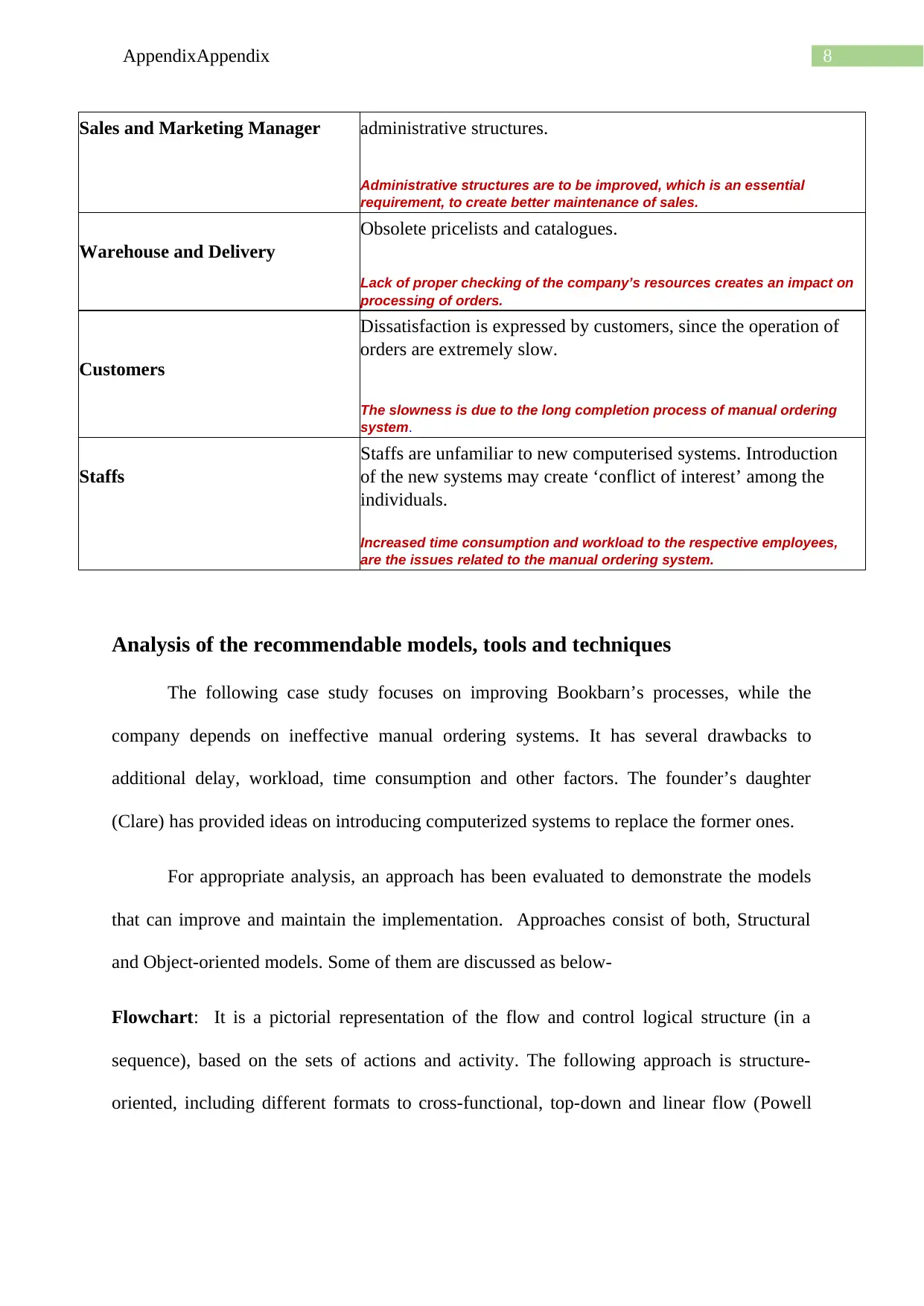
8AppendixAppendix
Sales and Marketing Manager administrative structures.
Administrative structures are to be improved, which is an essential
requirement, to create better maintenance of sales.
Warehouse and Delivery
Obsolete pricelists and catalogues.
Lack of proper checking of the company’s resources creates an impact on
processing of orders.
Customers
Dissatisfaction is expressed by customers, since the operation of
orders are extremely slow.
The slowness is due to the long completion process of manual ordering
system.
Staffs
Staffs are unfamiliar to new computerised systems. Introduction
of the new systems may create ‘conflict of interest’ among the
individuals.
Increased time consumption and workload to the respective employees,
are the issues related to the manual ordering system.
Analysis of the recommendable models, tools and techniques
The following case study focuses on improving Bookbarn’s processes, while the
company depends on ineffective manual ordering systems. It has several drawbacks to
additional delay, workload, time consumption and other factors. The founder’s daughter
(Clare) has provided ideas on introducing computerized systems to replace the former ones.
For appropriate analysis, an approach has been evaluated to demonstrate the models
that can improve and maintain the implementation. Approaches consist of both, Structural
and Object-oriented models. Some of them are discussed as below-
Flowchart: It is a pictorial representation of the flow and control logical structure (in a
sequence), based on the sets of actions and activity. The following approach is structure-
oriented, including different formats to cross-functional, top-down and linear flow (Powell
Sales and Marketing Manager administrative structures.
Administrative structures are to be improved, which is an essential
requirement, to create better maintenance of sales.
Warehouse and Delivery
Obsolete pricelists and catalogues.
Lack of proper checking of the company’s resources creates an impact on
processing of orders.
Customers
Dissatisfaction is expressed by customers, since the operation of
orders are extremely slow.
The slowness is due to the long completion process of manual ordering
system.
Staffs
Staffs are unfamiliar to new computerised systems. Introduction
of the new systems may create ‘conflict of interest’ among the
individuals.
Increased time consumption and workload to the respective employees,
are the issues related to the manual ordering system.
Analysis of the recommendable models, tools and techniques
The following case study focuses on improving Bookbarn’s processes, while the
company depends on ineffective manual ordering systems. It has several drawbacks to
additional delay, workload, time consumption and other factors. The founder’s daughter
(Clare) has provided ideas on introducing computerized systems to replace the former ones.
For appropriate analysis, an approach has been evaluated to demonstrate the models
that can improve and maintain the implementation. Approaches consist of both, Structural
and Object-oriented models. Some of them are discussed as below-
Flowchart: It is a pictorial representation of the flow and control logical structure (in a
sequence), based on the sets of actions and activity. The following approach is structure-
oriented, including different formats to cross-functional, top-down and linear flow (Powell
⊘ This is a preview!⊘
Do you want full access?
Subscribe today to unlock all pages.

Trusted by 1+ million students worldwide
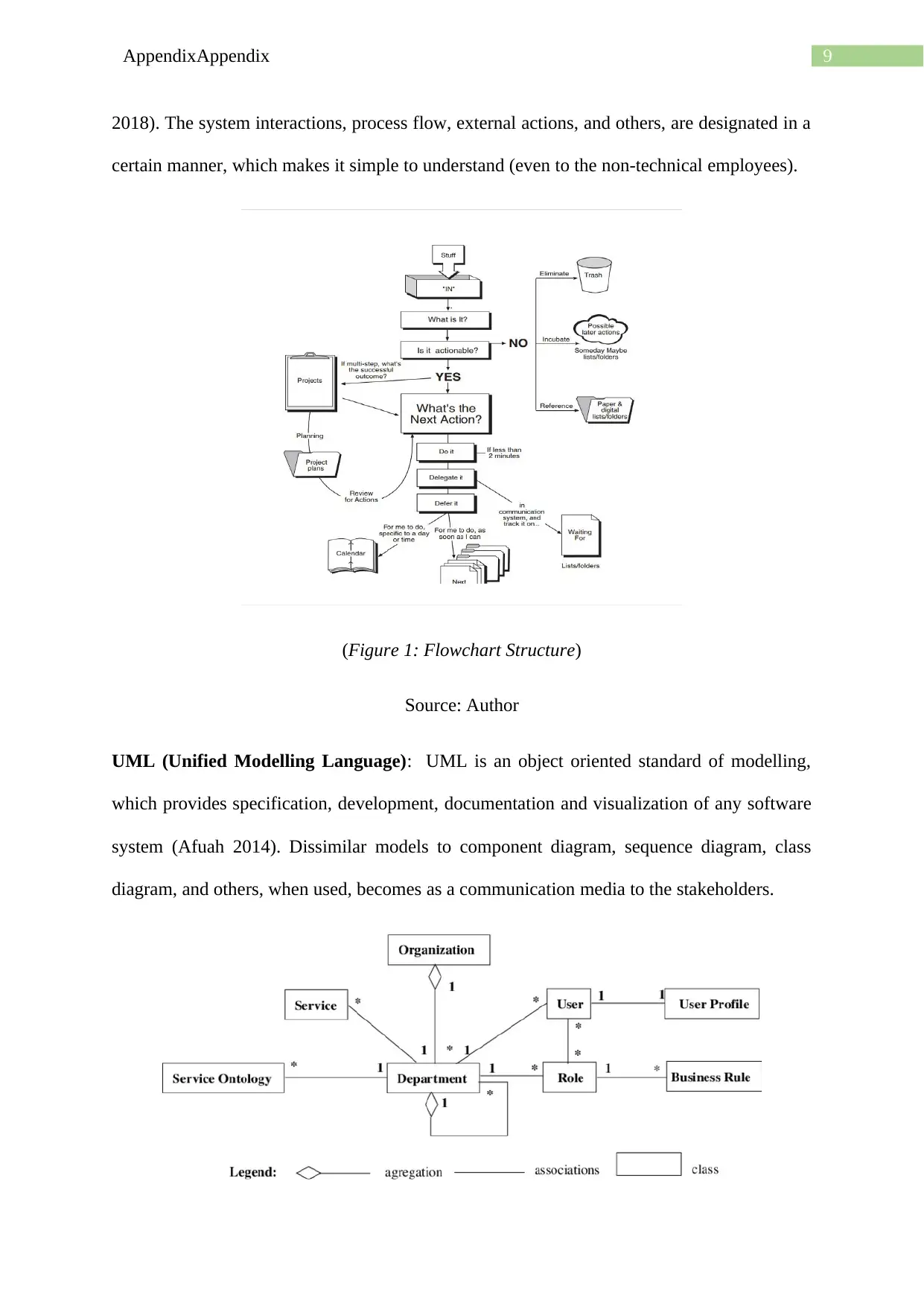
9AppendixAppendix
2018). The system interactions, process flow, external actions, and others, are designated in a
certain manner, which makes it simple to understand (even to the non-technical employees).
(Figure 1: Flowchart Structure)
Source: Author
UML (Unified Modelling Language): UML is an object oriented standard of modelling,
which provides specification, development, documentation and visualization of any software
system (Afuah 2014). Dissimilar models to component diagram, sequence diagram, class
diagram, and others, when used, becomes as a communication media to the stakeholders.
2018). The system interactions, process flow, external actions, and others, are designated in a
certain manner, which makes it simple to understand (even to the non-technical employees).
(Figure 1: Flowchart Structure)
Source: Author
UML (Unified Modelling Language): UML is an object oriented standard of modelling,
which provides specification, development, documentation and visualization of any software
system (Afuah 2014). Dissimilar models to component diagram, sequence diagram, class
diagram, and others, when used, becomes as a communication media to the stakeholders.
Paraphrase This Document
Need a fresh take? Get an instant paraphrase of this document with our AI Paraphraser
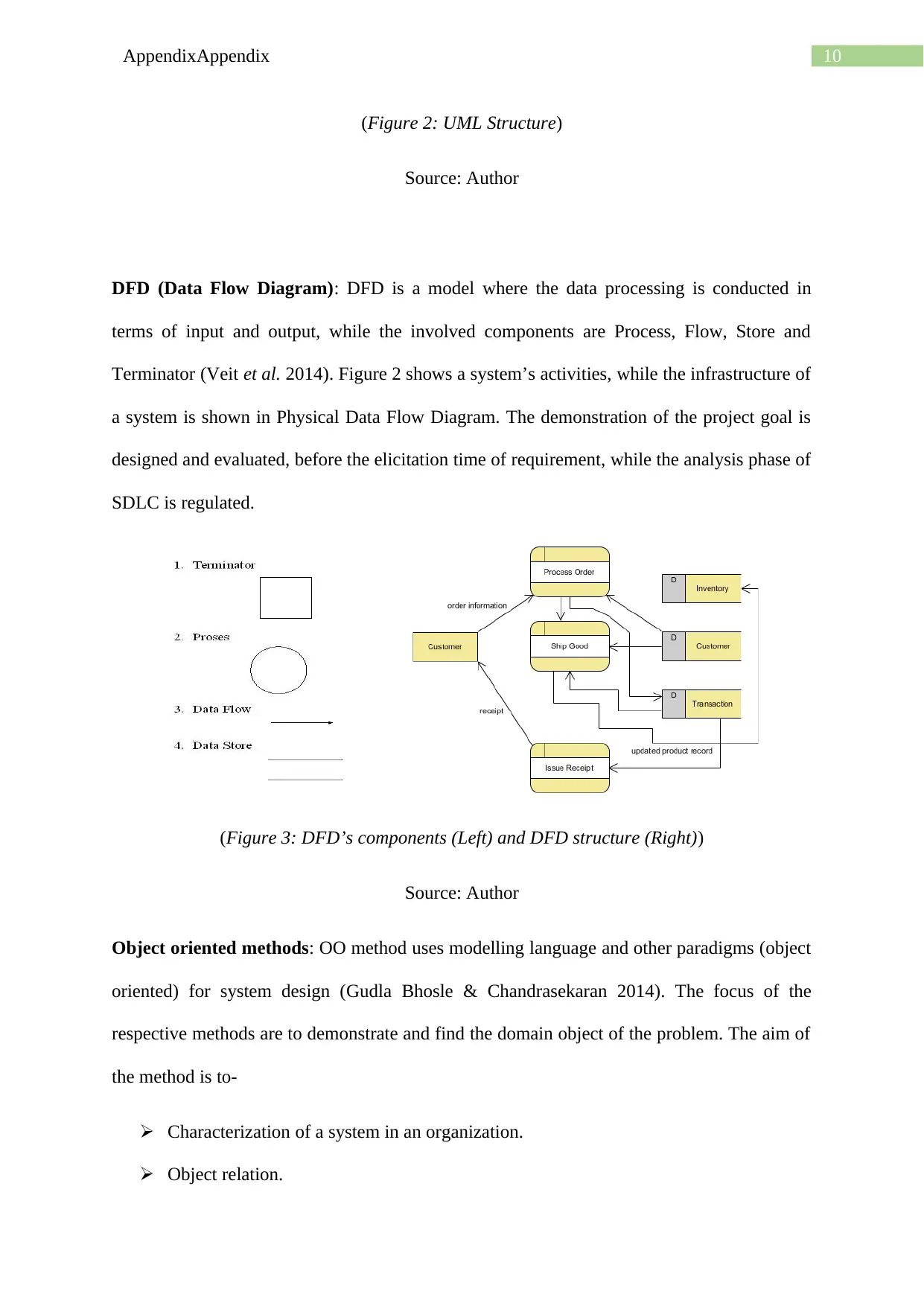
10AppendixAppendix
(Figure 2: UML Structure)
Source: Author
DFD (Data Flow Diagram): DFD is a model where the data processing is conducted in
terms of input and output, while the involved components are Process, Flow, Store and
Terminator (Veit et al. 2014). Figure 2 shows a system’s activities, while the infrastructure of
a system is shown in Physical Data Flow Diagram. The demonstration of the project goal is
designed and evaluated, before the elicitation time of requirement, while the analysis phase of
SDLC is regulated.
(Figure 3: DFD’s components (Left) and DFD structure (Right))
Source: Author
Object oriented methods: OO method uses modelling language and other paradigms (object
oriented) for system design (Gudla Bhosle & Chandrasekaran 2014). The focus of the
respective methods are to demonstrate and find the domain object of the problem. The aim of
the method is to-
Characterization of a system in an organization.
Object relation.
(Figure 2: UML Structure)
Source: Author
DFD (Data Flow Diagram): DFD is a model where the data processing is conducted in
terms of input and output, while the involved components are Process, Flow, Store and
Terminator (Veit et al. 2014). Figure 2 shows a system’s activities, while the infrastructure of
a system is shown in Physical Data Flow Diagram. The demonstration of the project goal is
designed and evaluated, before the elicitation time of requirement, while the analysis phase of
SDLC is regulated.
(Figure 3: DFD’s components (Left) and DFD structure (Right))
Source: Author
Object oriented methods: OO method uses modelling language and other paradigms (object
oriented) for system design (Gudla Bhosle & Chandrasekaran 2014). The focus of the
respective methods are to demonstrate and find the domain object of the problem. The aim of
the method is to-
Characterization of a system in an organization.
Object relation.
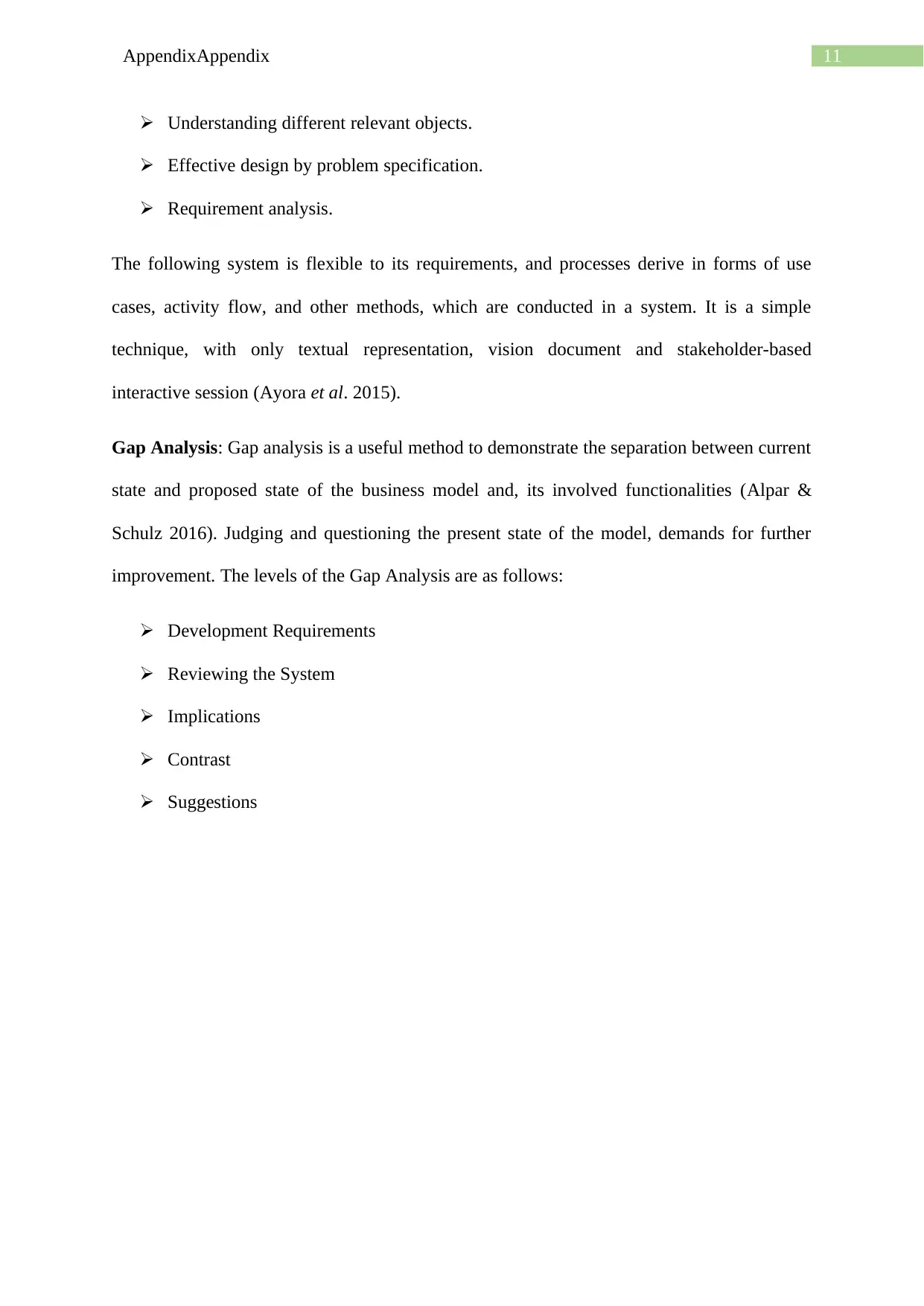
11AppendixAppendix
Understanding different relevant objects.
Effective design by problem specification.
Requirement analysis.
The following system is flexible to its requirements, and processes derive in forms of use
cases, activity flow, and other methods, which are conducted in a system. It is a simple
technique, with only textual representation, vision document and stakeholder-based
interactive session (Ayora et al. 2015).
Gap Analysis: Gap analysis is a useful method to demonstrate the separation between current
state and proposed state of the business model and, its involved functionalities (Alpar &
Schulz 2016). Judging and questioning the present state of the model, demands for further
improvement. The levels of the Gap Analysis are as follows:
Development Requirements
Reviewing the System
Implications
Contrast
Suggestions
Understanding different relevant objects.
Effective design by problem specification.
Requirement analysis.
The following system is flexible to its requirements, and processes derive in forms of use
cases, activity flow, and other methods, which are conducted in a system. It is a simple
technique, with only textual representation, vision document and stakeholder-based
interactive session (Ayora et al. 2015).
Gap Analysis: Gap analysis is a useful method to demonstrate the separation between current
state and proposed state of the business model and, its involved functionalities (Alpar &
Schulz 2016). Judging and questioning the present state of the model, demands for further
improvement. The levels of the Gap Analysis are as follows:
Development Requirements
Reviewing the System
Implications
Contrast
Suggestions
⊘ This is a preview!⊘
Do you want full access?
Subscribe today to unlock all pages.

Trusted by 1+ million students worldwide
1 out of 22
Related Documents
Your All-in-One AI-Powered Toolkit for Academic Success.
+13062052269
info@desklib.com
Available 24*7 on WhatsApp / Email
![[object Object]](/_next/static/media/star-bottom.7253800d.svg)
Unlock your academic potential
Copyright © 2020–2025 A2Z Services. All Rights Reserved. Developed and managed by ZUCOL.





